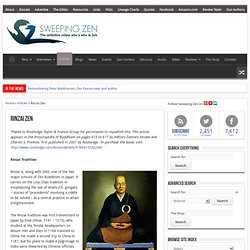

Zen and the Eastern Spirit_Koan practice in Rinzai Zen. The Rinzai sect of Zen tries to exhaustively inquire into the "selfless self" using koans (Zen cases), but the present situation of the Rinzai sect has become a corrupt ritual devoid of substance.It is only concerned with counting the number of passed koans.

To save Koan Zen from this predicament, so that we may again obtain the joy of the dharma, we must return to the original principle of "illuminating the fundamental single mind". 1, Zen as the Great and Fundamental Way As has already been stated, Confucianism, Shinto and Buddhism have attempted to attain and maintain the fundamental state of selflessness. However, unfortunately, the method has not been clearly established in Confucianism. Because of this, even though there are scholars still engaged in interpreting and commenting on Confucian texts, persons who have truly embodied the teachings of Confucianism have not existed in Japan since the end of the Edo era (i.e., for more than 130 years). 2, The Problem of Koan Zen. Zenrinzai. RINZAI ROKU The Sayings of Master Rinzai (A Selection) TRANS: D.T. Suzuki Those of you who. RINZAI ROKU The Sayings of Master Rinzai (A Selection) TRANS: D.T.

Suzuki Those of you who wish to discipline themselves in the Buddha's Dharma must seek true understanding. When this understanding is attained you will not be defiled by birth and death. Whether walking or standing still, you will be your own master. Even when you are not trying to achieve something extraordinary, it will come to you all by itself. O Followers of the Way, from olden times each of my predecessors had his own way of training his disciples. Sweeping Zen. Thanks to Routledge Taylor & Francis Group for permission to republish this.

This article appears in the Encyclopedia of Buddhism on pages 615 to 617 by editors Damien Keown and Charles S. Prebish, first published in 2007 by Routledge. To purchase the book, visit: Rinzai Tradition Rinzai is, along with Sōtō, one of the two major schools of Zen Buddhism in Japan. The Rinzai tradition was first transmitted to Japan by Eisai (Yōsai, 1141 – 1215), who studied at the Tendai headquarters on Mount Hiei and then in 1168 traveled to China. Eisai is recognized as the founder of the Rinzai school of Zen Buddhism in Japan, but Eisai himself taught an eclectic “mixed” form of Buddhism that included many elements from the esoteric tradition. The Rinzai Zen tradition after Eisai, reinforced by cultured Chinese monks escaping to Japan to avoid the Mongols, was patronized by the warrior elite and aristocratic families, eventually forming the cultural centers of the Five Mountains (gozan) temples.
Rinzai school. The Rinzai school (臨済宗; Japanese: Rinzai-shū, Chinese: 临济宗 línjì zōng) is one of three sects of Zen in Japanese Buddhism (with Sōtō and Ōbaku).

History[edit] Rinzai is the Japanese line of the Chinese Linji school, which was founded during the Tang Dynasty by Linji Yixuan (Japanese: Rinzai Gigen). Kamakura (1185–1333)[edit] Though there were several attempts to establish Rinzai lines in Japan, it first took root in a lasting way through the efforts of the monk Myōan Eisai. In 1168 Myōan Eisai traveled to China, whereafter he studied Tendai for twenty years. The time during which Rinzai Zen was established in Japan also saw the rise of the samurai to power. Muromachi (or Ashikaga) (1336–1573)[edit] During the Muromachi period the Rinzai school was the most successful of the schools, since it was favoured by the Shogun. Five Mountain System[edit] In the beginning of the Muromachi period the Five Mountain System (Gozan) system was fully worked out.
Rinka-monasteries[edit] Hakuin[edit] Obaku[edit]